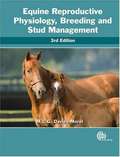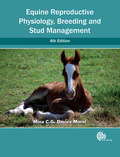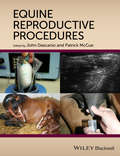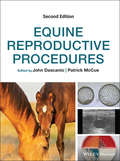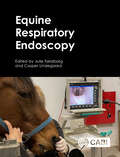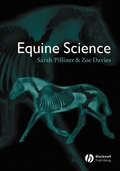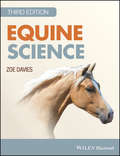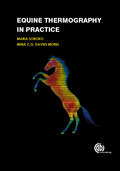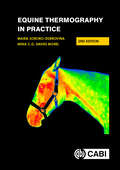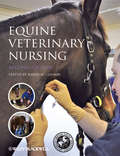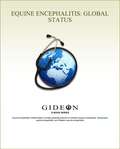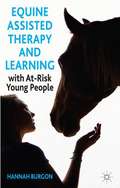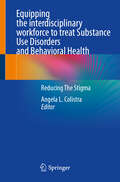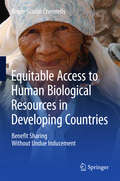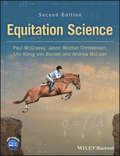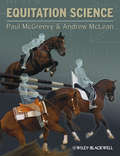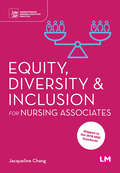- Table View
- List View
Equine Reproductive Physiology, Breeding and Stud Management, 3rd Edition
by Mina Davies MorelThis third edition of the highly successful textbook is updated throughout and printed in two colours in a new larger format. Coverage includes the reproductive anatomy, endocrine control and selection for breeding of both the mare and stallion, and also pregnancy, parturition and lactation in the mare. This comprehensive text goes on to study how this knowledge can be applied to the successful breeding of horses, maximizing both productivity and animal welfare. It has also been expanded to include more recent experimental work and updated references, including a brand new chapter on the significant developments in embryo technology. This widely popular textbook is an essential addition to the collections of both students in equine science and practising veterinarians. " Extensively illustrated with over 240 diagrams and photographs " New larger format printed in two colours throughout " New coverage of developments in embryo technology " Updated references Readership: HND, degree and post graduate courses in Equine science/studies; veterinary science students, stud managers/practitioners Quotes about the prev. editions: "This book is a proven success as a textbook for degree and diploma courses in equine studies. It also has proved to be a useful supplementary text for veterinary students, as well as valuable for veterinary practitioners and stud managers" - Journal of Equine Veterinary Science "A very useful book for veterinary students, veterinarians, reproductive physiologists and farm managers" - Animal Welfare "The book is packed with practical information that is well organised and is presented in a readily available format" - G. W. C. England "This book is ideal for its targeted readers and for anyone wanting to know and understand the why and how of running a horse or pony breeding enterprise. ...an excellent handy reference for the practise shelf" - D. M. Carson, The Veterinary Record "This book is for the breeder or hairy ponies and for the student of equine science alike" - M. E. Mcgillivary, The Ark "...this textbook will be useful for both horse owners and veterinarians" - R. M. Löfstedt, Canadian Veterinary Journal
Equine Reproductive Physiology, Breeding and Stud Management, 4th Edition
by Mina Davies MorelThe fourth edition of this popular textbook provides a comprehensive account of how to successfully breed horses. Updated throughout, the new edition will cover techniques such as cloning, intra-cytoplasmic sperm injections (ICSI), in vitro fertilisation (IVF) and related reproductive technology that is currently being developed. This book also looks at reproductive anatomy, endocrine control and selection for breeding mares and stallions, and pregnancy, parturition and lactation in the mare. This classic textbook is required reading for many equine science and related courses, particularly in the UK.
Equine Reproductive Procedures
by Patrick Mccue John DascanioEquine Reproductive Procedures is a user-friendly guide to reproductive management, diagnostic techniques, and therapeutic techniques on stallions, mares, and foals. Offering detailed descriptions of 161 procedures ranging from common to highly specialized, the book gives step-by-step instructions with interpretative information, as well as useful equipment lists and references for further reading. Presented in a highly portable spiral-bound format, Equine Reproductive Procedures is a practical resource for daily use in equine practice. Divided into sections on the non-pregnant mare, the pregnant mare, the postpartum mare, the stallion, and the newborn foal, the book is well-illustrated throughout with clinical photographs demonstrating procedures. Equine Reproductive Procedures provides practical guidance for performing basic and advanced techniques associated with the medical management of horses.
Equine Reproductive Procedures
by John Dascanio Patrick McCueThis fully updated guide examines techniques in equine theriogenology The second edition of Equine Reproductive Procedures provides equine practitioners, veterinary students, and equine theriogenologists with a fully updated, practical guide to techniques in equine reproductive practice. This easy-to-use resource covers skills-based information with a clinical focus, taking an easy-to-follow step-by-step approach. The book covers topics related to the reproductive management of horses, including diagnostic techniques and therapeutic procedures for stallions, mares, and foals. Procedures highlighted in the book are supported with clear descriptions and photographs. Readers will also find a list of required supplies for the procedure and a reference list. · Provides step-by-step descriptions of techniques related to equine theriogenology · Serves as a valuable practice tool · Offers 39 new techniques not found in the first edition · Includes key updates to existing techniques Those studying equine reproduction and specialists in theriogenology will find this an essential ‘how-to’ guide for their practice library.
Equine Respiratory Endoscopy
by Eileen Hackett Emmanuelle van Erck-Westergren Eric Strand J. F. Pycock Keith Edward Baptiste Lise Charlotte Berg Michael Röcken Doreen Scharner Modest Vengust Olivier M. Lepage Padraic M Dixon Rjm Reardon R. Scott Pirie Rebecca C. McOnie Sanni HansenRespiratory endoscopy is a key diagnostic tool, but species-specific references can be difficult to find. Providing the first practical approach to equine respiratory endoscopy, this book allows veterinarians to review this procedure for their most valuable clients. It includes: Full colour endoscopy images illustrating normal anatomy, variations of normal anatomy, and disorders of the respiratory tract, to aid the reader in diagnosis. Clinically relevant case studies to help translate theoretical knowledge into practical applications. Information on both resting and overground endoscopy. Written by experts from across the globe, this book converts their insights and experience into one invaluable resource for general equine practitioners.
Equine Science
by Sarah Pilliner Zoe DaviesEquine Science provides – in one book – all the essential scientific knowledge students require. Describing the structure and function of the various body systems and clearly explaining the scientific rationale behind modern horse husbandry practices, this book has been written specifically for students on National and Higher Diploma courses and equine studies degree programmes, Advanced National Certificate and BHS Stage IV. The second edition has been revised to reflect the changes in the student curriculum, and the book includes two new chapters on the cell and genetics. The Authors Sarah Pilliner is an equine consultant specialising in horse care. She is also an experienced lecturer, competition rider and senior examiner, and the author of several books. Zoe Davies is a former lecturer in equine science, a consultant equine nutritionist, author and external examiner for higher education courses. She has substantial experience in equine management and training.
Equine Science
by Zoe DaviesFrom genetics to functional anatomy, cell biology to the equine digestive system, Equine Science, Third Edition covers all the essential scientific knowledge you need for your equine programme. Thoroughly updated, this new edition features a clear, systematic presentation, stunning full-colour photographs and illustrations, chapter summary points and self-assessment questions throughout. Describes the structure and function of the various body systems of the horse Explains the scientific rationale behind modern equine training practices Features new chapters on exercise physiology and the evolution of the horse Reflects the latest scientific advances and changes in the student curriculum Includes new information on circadian rhythms and sleep patterns, the immune system, and hindgut microbiology. A powerful teaching and learning aid, Equine Science, Third Edition is an essential text for students on higher education equine studies and equine science programmes, as well as those studying for BHS qualifications up to BHSII Stage 4 Horse Knowledge and Care.
Equine Thermography in Practice
by Mina Davies Morel Dr Maria SorokoEvidence-based and yet very practical, Equine Thermography in Practice discusses how to use the tool in the diagnosis of equine musculoskeletal injuries and what the user can expect to see in normal versus injured horses giving guidelines for best practice. The book builds from basics covering the principles of thermography and then its applications in equine veterinary medicine and the role of the technique regarding the equestrian athlete as well as in rehabilitation. Extensively illustrated and thoroughly referenced, this book is indispensable to novice and experienced practitioners using the technique, including: equine veterinarians and equine physiotherapists and body work practitioners.
Equine Thermography in Practice
by Dr Maria Soroko Mina Davies MorelEvidence-based and yet very practical, Equine Thermography in Practice discusses how to use the tool in the diagnosis of equine musculoskeletal injuries and what the user can expect to see in normal versus injured horses giving guidelines for best practice. The book builds from basics covering the principles of thermography and then its applications in equine veterinary medicine and the role of the technique regarding the equestrian athlete as well as in rehabilitation. Extensively illustrated and thoroughly referenced, this book is indispensable to novice and experienced practitioners using the technique, including: equine veterinarians and equine physiotherapists and body work practitioners.
Equine Thermography in Practice
by Mina C Davies Morel Dr Maria Soroko-DubrovinaEvidence-based and yet very practical, Equine Thermography in Practice discusses how to use the tool in the diagnosis of equine musculoskeletal injuries. It covers what the user can expect to see in normal versus injured horses, giving guidelines for best practice. The book builds on the basics covering the principles of thermography, then reviews its applications in equine veterinary medicine and the role of the technique regarding equestrian athletes and rehabilitation. Fully updated throughout with new references and additional illustrative case studies, this new edition: - Covers advances made in thermography applications for rehabilitation, such as assessing the effectiveness of physical devices like lasers, magnetic therapy, shock wave therapy and cryotherapy with additional updated references. - Includes new cases and thermographic images to illustrate improvements in the technology. - Updates knowledge on thermographic imaging technology. - Extensively illustrated and thoroughly referenced, this book is indispensable for both novice and experienced practitioners using the technique, including equine veterinarians, and equine physiotherapists and body work practitioners.
Equine Thermography in Practice
by Maria Soroko Mina C.G. Davies MorelEvidence-based and yet very practical, Equine Thermography in Practice discusses how to use the tool in the diagnosis of equine musculoskeletal injuries and what the user can expect to see in normal versus injured horses giving guidelines for best practice. The book builds from basics covering the principles of thermography and then its applications in equine veterinary medicine and the role of the technique regarding the equestrian athlete as well as in rehabilitation. Extensively illustrated and thoroughly referenced, this book is indispensable to novice and experienced practitioners using the technique, including: equine veterinarians and equine physiotherapists and body work practitioners.
Equine Veterinary Nursing
by Karen CoumbeThe breadth and depth of expertise essential for equine veterinary nursing today is provided in this definitive textbook. Thoroughly revised and updated in its second edition, and now fully illustrated in colour. This book covers the content of the ever-expanding equine nursing syllabus, while still succinctly covering all the basics that veterinary nurses specialising in other species need to know. The key subjects included are: basic equine management, medical and surgical equine nursing, nutrition, reproduction and foal care, emergency first aid, and the theory underpinning these and other important topics.Equine Veterinary Nursing Second Edition is presented in a clear and user-friendly manner, appropriate for all those involved in equine nursing. A practical approach is used throughout and procedures are illustrated with a large number of line diagrams and clinical photographs. It is an essential manual for all student and qualified equine veterinary nurses and all those involved in the care of horses.KEY FEATURESIncludes a new chapter on the equine nurse's professional responsibilitiesMajor revisions to the chapters on diagnostic imaging and surgical nursing to reflect advances in technology and techniquesAll information on health and safety management updated in keeping with new regulationsAuthors include both vets and experienced equine nursesEndorsed by the British Equine Veterinary Association"With the increasing demands of equine practice has come the need for well trained and competent equine nurses. There have been significant improvements in and expansion of the equine Veterinary Nurse training syllabus over the past few years to meet these demands. This new and updated edition of Equine Veterinary Nursing covers all aspects of the new syllabus with well written and illustrated chapters from a wide range of knowledgable and experienced authors. The British Equine Veterinary Association is pleased to endorse this text as a 'must have' for all trainee equine veterinary nurses and their training practices." - Deidre M Carson BVSc(Syd) MRCVSImmediate Past President, BEVA
Equine Welfare (UFAW Animal Welfare #8)
by Bernard E. Rollin C. Wayne McIlwraithA rational exploration of the ethical and welfare issues in all areas of equine use. This book addresses controversial and emotive issues surrounding these iconic creatures, providing a reliable source of information to support informed debate. It will enable all those with an interest in horses and the uses they are put to gain an awareness of the problems and abuses that occur. The book draws on the expertise of a range of acknowledged leaders in equine health and welfare. The first part of the book explores general issues of the horse’s needs and nature. The second part contains chapters each covering a specific human use of horses and the abuses that arise as a result. This book is part of the UFAW/Wiley-Blackwell Animal Welfare Book Series. This major series of books produced in collaboration between UFAW (The Universities Federation for Animal Welfare), and Wiley-Blackwell provides an authoritative source of information on worldwide developments, current thinking and best practice in the field of animal welfare science and technology. For details of all of the titles in the series see www.wiley.com/go/ufaw.
Equine Wound Management
by Jim Schumacher Christine L. TheoretNow in its third edition, Equine Wound Management is the authoritative resource for both theoretical and practical information on the care of wounds in horses. The most comprehensive resource on managing equine wounds Organized by body region Over 750 color photographs Summaries at the beginning of each chapter and highlighted key information aid readers to rapidly find relevant information Companion website offers videos, interactive multiple choice questions and answers, case studies, and images from the book for download
Equine encephalitis: Global Status 2010 edition
by Dr Stephen Berger Gideon InformaticsEquine encephalitis: Global Status is one in a series of GIDEON ebooks which summarize the status of individual infectious diseases, in every country of the world. Data are based on the GIDEON database (www.gideononline.com) which relies on standard text books, peer-review journals, Health Ministry reports and ProMED, supplemented by an ongoing search of the medical literature. Chapters are arranged alphabetically, by country name. Each section is divided into six subsections. 1. Descriptive epidemiology 2. Summary of clinical features 3. Global status of the disease4. Potential use in Bioterrorism 5. Status of the disease in a specific country 6. References Equine encephalitis: Global Status includes separate sections on Eastern equine encephalitis, Venezuelan equine encephalitis, and Western equine encephalitis.
Equine-Assisted Therapy and Learning with At-Risk Young People
by Hannah Louise BurgonThis book provides an overview of the field of Equine-Assisted Therapy and Learning and gives a powerful account of a research study charting the experiences of seven 'at-risk' young people attending a pioneering Therapeutic Horsemanship centre in the UK. The book includes a foreword from Leif Hallberg, author of Walking the Way of the Horse .
Equipping the interdisciplinary workforce to treat Substance Use Disorders and Behavioral Health: Reducing The Stigma
by Angela L. ColistraThe U.S. faces a critical crisis in behavioral health and addiction care. Overburdened emergency rooms and primary care offices struggle with lengthy wait times, while workforce shortages and systemic barriers disproportionately impact marginalized communities. This has resulted in the criminal justice system becoming a de facto provider of mental health and addiction services. In 2024, Surgeon General Dr. Vivek Murthy declared a national epidemic of loneliness and isolation, exacerbated by the COVID-19 and opioid crises. His advisory underscores the importance of social connection, empathy, and belonging as vital components of well-being. Despite the urgent need, stigma surrounding mental health and substance use disorders persists, hindering access to care. Historically, training programs have underemphasized addiction and behavioral health education across medical and behavioral health disciplines. This book serves as a vital resource for interdisciplinary teams, highlighting the crucial role each profession plays in improving access to addiction and mental health care and reducing stigma. It advocates for a collaborative, relationship-centered approach, equipping clinicians and peers with the knowledge and skills to effectively address addiction and behavioral health within communities. Expertly written and reviewed, it offers up-to-date scientific and clinical information spanning a broad range of relevant topics.
Equitable Access to Human Biological Resources in Developing Countries
by Roger Scarlin ChennellsThe main question explored by the book is: How can cross-border access to human genetic resources, such as blood or DNA samples, be governed in such a way as to achieve equity for vulnerable populations in developing countries? The book situates the field of genomic and genetic research within global health and research frameworks, describing the concerns that have been raised about the potential unfairness in exchanges during recent decades. Access to and sharing in the benefits of human biological resources are aspects not regulated by any international legal framework such as the Convention on Biological Diversity, which applies only to the exchange of plants, animals and microorganisms, as well as to associated traditional knowledge. Examples of genetic research perceived as exploitative are provided in order to illustrate the legal vacuum concerning the global governance of human genetic resources. The main conclusions drawn from the legal and ethical analysis are: * Benefit sharing is crucial in order to avoid the exploitation of developing countries in human genetic research. * With functioning research ethics committees, undue inducement is less of a concern in genetic research than in other areas of medical research (e. g. clinical trials). * Concerns remain over research involving indigenous populations; accordingly, recommendations are provided. In drawing these conclusions, the book addresses in detail a highly pressing topic in global bioethics and international law. In this regard, it combines bioethical arguments with jurisprudence, in particular with reference to the law of equity and the legal concepts of duress (coercion), unconscionable dealing, and undue inducement.
Equitation Science
by Paul McGreevy Janne Winther Christensen Uta König von Borstel Andrew McLeanA new edition of a highly respected textbook and reference in the rapidly emerging field of equitation science. Equitation Science, 2nd Edition incorporates learning theory into ethical equine training frameworks suitable for riders of any level and for all types of equestrian activity. Written by international experts at the forefront of the development of the field, the welfare of the horse and rider safety are primary considerations throughout. This edition features a new chapter on research methods, and a companion website provides the images from the book in PowerPoint.
Equitation Science: Equitation Science In Practice
by Paul McGreevy Andrew McLeanWritten by two internationally recognised experts, Equitation Science is the first book to draw together the principles of this emerging field into a much-needed coherent source of information. The goal of equitation science is to enhance our understanding of how horses think and learn, and to use their natural behaviour to train, ride or compete with them in as fair a manner as possible. The welfare consequences of training and competing horses under different protocols are explored. Drawing on traditional and emergent techniques, this book incorporates learning theory into an ethical equine training system suitable for all levels. It also focuses on evidence-based approaches that improve rider safety. "Equitation Science is one of those rare books that is going to change the way we train and manage horses forever. It brings together a fundamental understanding of the way horses think and behave and presents a system of modern training that has the welfare of the horse at its core – it must be the foundation work for the next generation of professional and amateur riders and trainers. Riders will ride better, trainers will train better and we will have happier, healthier horses."—Wayne Channon, International Grand Prix Rider "I found this a very interesting and enlightening book. Equitation Science will help anyone involved with horses to understand them more and to be more effective in their training and education. The knowledge this brings to anyone involved with horses should help to make the horses’ lives easier and therefore allow the partnership between humans and equines to flourish."—Yogi Breisner, British Eventing Performance Manager "Equitation Science is an ambitious and thorough look at an enormous range of areas, approaches and factors concerning the training of horses. The authors have an underlying theme to their text of scientifically assessing and then also promoting the use of ethical and humane methods of horse training to increase all sport horses’ welfare and happiness within their sporting requirements. Equitation Science also provides an invaluable insight as to how and why what we do with our horses actually works."—Paul Tapner, Professional International Advanced Eventing Rider, Badminton CCI**** 2010 Winner
Equity in Health and Health Promotion in Urban Areas: Multidisciplinary Interventions at International and National Level (Green Energy and Technology)
by Alessandra Battisti Maurizio Marceca Silvia Iorio Giuseppe RicottaThe book explores approaches, methods and best practices related to health promotion in urban areas. Thanks to the increasingly tight connection among urbanism, architecture, bioethics, anthropology, sociology and medicine, we are now reaching an “ecological” health perspective. This new viewpoint has pushed the study of social health determinants and their unequal distribution in the population, resulting in the study of the generation of structurally-determined differences in health and healthcare. There is the need to make use of a unitary framework in order to understand the intertwining of multidimensional dynamics that define the urban context and the need to disseminate, enhance, and improve existing interventions in the field. This volume consequently results in the discussion and comparison of contents and methods to be implemented in multidisciplinary interventions related to the promotion of community-based healthcare and health in the urban setting. The book represents a useful opportunity for scientific growth and international sharing of methodologies that can help develop a common language and approach to be shared across different academic spheres. This is not only an exchange of knowledge among different fields of study, but also the creation of foundations for creating an increasingly complex network of scientific culture and operational collaborations to transfer knowledge and attract academic and public attention, influencing decision-makers and gaining advocacy accordingly.
Equity, Diversity and Inclusion for Nursing Associates (Understanding Nursing Associate Practice)
by Jacqueline ChangNursing Associates work in a culturally diverse world and care for people with a variety of backgrounds, identities and beliefs. This book introduces you to the key principles of equity, diversity and inclusion that you need to follow in order to challenge poor practice and provide excellent person-centred care. Covering important topics such as unconscious bias, legal requirements and professional standards, this book will guide you through applying what you’ve learnt and maintaining EDI principles within your career. Key features Fully mapped to the NMC Standards of Proficiency for Nursing Associates (2018) Explains the key legal, professional and ethical EDI standards you need to understand in order to provide excellent person-centred care to a diverse range of patients Case studies and activities encourage self-reflection and illustrate what EDI looks across different healthcare settings Written specifically to address the unique experiences, challenges and requirements of the nursing associate role
Equity, Diversity and Inclusion for Nursing Associates (Understanding Nursing Associate Practice)
by Jacqueline ChangNursing Associates work in a culturally diverse world and care for people with a variety of backgrounds, identities and beliefs. This book introduces you to the key principles of equity, diversity and inclusion that you need to follow in order to challenge poor practice and provide excellent person-centred care. Covering important topics such as unconscious bias, legal requirements and professional standards, this book will guide you through applying what you’ve learnt and maintaining EDI principles within your career. Key features Fully mapped to the NMC Standards of Proficiency for Nursing Associates (2018) Explains the key legal, professional and ethical EDI standards you need to understand in order to provide excellent person-centred care to a diverse range of patients Case studies and activities encourage self-reflection and illustrate what EDI looks across different healthcare settings Written specifically to address the unique experiences, challenges and requirements of the nursing associate role
Equivocal Child Abuse
by Sandra B. McPherson Farshid AfsarifardChild abuse cases with hard-to-prove allegations pose challenges for all those who seek to protect the welfare of children. Helping courts, evaluators, guardians, and lawyers understand and work with difficult cases, Equivocal Child Abuse brings together insights, experience, and guidance from multiple sources to minimize unnecessary harm done to c
Equus Lost?
by Francesco De GiorgioIn the 1980s, the world of riding, training, and competing with horses took a major turn with the spread of natural horsemanship, which at its most basic foundation rejects the use of abusive techniques and relies on methods derived from understanding the dynamics of free-roaming horse herds. Since then, equestrians across disciplines have incorporated elements of natural horsemanship into their work. But despite what was certainly an advancement in human-equine interaction that has improved the lives of many horses, Italian animal behaviorists Francesco de Giorgio and José Giorgio-Schoorl dare to now ask,What if much of what we think we know about horses is, in fact, wrong? What if the premise of herd hierarchy is a myth? What if conditioning the horse's behavior in the ways we've grown accustomed is undercutting his potential for development? What if there is another—better—level of partnership to which we can aspire?Their provocative book takes us into a dimension where we shed our assumptions of leadership, dominance, and control, convincingly showing a way forward that acknowledges that a horse, when allowed, is driven by his own inner motivation to explore and understand the world around him, including his relationship with humans.
